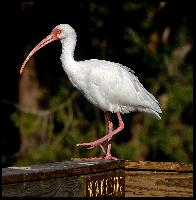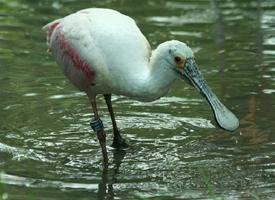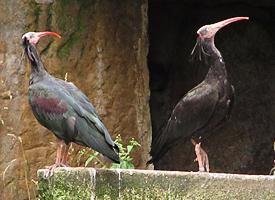
Poids et mesures
| Longueur | 65 cm |
|---|---|
| Envergure des ailes | 95 cm |
Description de l'animal
The American White Ibis (Eudocimus albus) is a striking and distinctive wading bird found primarily in the southeastern United States, as well as in parts of Central America and the northern regions of South America. This species is easily recognizable by its pure white plumage, which provides a sharp contrast to its vividly colored, down-curved bill and legs, which range in hue from bright red to pink. The bird's overall appearance is both elegant and robust, embodying a unique blend of delicacy and strength that captivates birdwatchers and nature enthusiasts alike.Adult American White Ibises measure approximately 53 to 70 centimeters (21 to 28 inches) in length, with a wingspan that can reach up to about 95 to 105 centimeters (37 to 41 inches). They exhibit sexual dimorphism, with males generally being larger and having slightly longer bills than females. Juveniles differ in appearance from adults, showcasing a mottled brown and white plumage that gradually transitions to the adult's all-white feathers as they mature.
One of the most fascinating aspects of the American White Ibis is its foraging behavior. These birds are often seen in shallow waters—fresh, brackish, or saltwater—probing the mud with their long, curved bills in search of prey. Their diet primarily consists of small aquatic prey, including fish, insects, frogs, and crustaceans. They are known to forage in groups, and their presence is indicative of a healthy wetland ecosystem.
The American White Ibis breeds in large colonies, often alongside other wading birds. Their nests are typically constructed in trees or bushes near water bodies. Both parents are involved in the nesting process, from building the nest out of sticks and reeds to incubating the eggs and feeding the chicks. The breeding season is marked by a change in the color of the bird's bill and legs, which intensify in hue, signaling their readiness to mate.
Migration patterns of the American White Ibis are complex and not fully migratory but are influenced by water levels and food availability. Birds in the northern parts of their range tend to move southward during colder months, while those in more tropical areas may remain in the same habitats year-round or move in response to seasonal rains.
The conservation status of the American White Ibis is currently listed as Least Concern by the International Union for Conservation of Nature (IUCN), indicating a stable population. However, they are not without threats; habitat destruction due to urbanization and changes in water management practices in wetlands can impact their feeding and breeding grounds. Additionally, pollution and changes in climate can affect their food availability and nesting sites.
In many cultures, the American White Ibis holds significant symbolism and is admired for its beauty and grace. It has also been the subject of numerous studies on wetland ecology, given its role as a key species in its habitat. Observing these birds in their natural environment provides not only an opportunity to appreciate their elegance but also a reminder of the importance of conserving the wetlands that support a diverse range of wildlife.
Animaux similaires
Nouvelles photos d'animaux
Top 10 des animaux
- Dolphin gull (Leucophaeus scoresbii)
- Japanese macaque (Macaca fuscata)
- Stone loach (Barbatula barbatula)
- Greek tortoise (Testudo graeca)
- Russian tortoise (Testudo horsfieldii)
- Galápagos tortoise (Geochelone nigra complex)
- Diana monkey (Cercopithecus diana)
- Moustached guenon (Cercopithecus cephus)
- Common flying dragon (Draco volans)
- Galápagos penguin (Spheniscus mendiculus)


